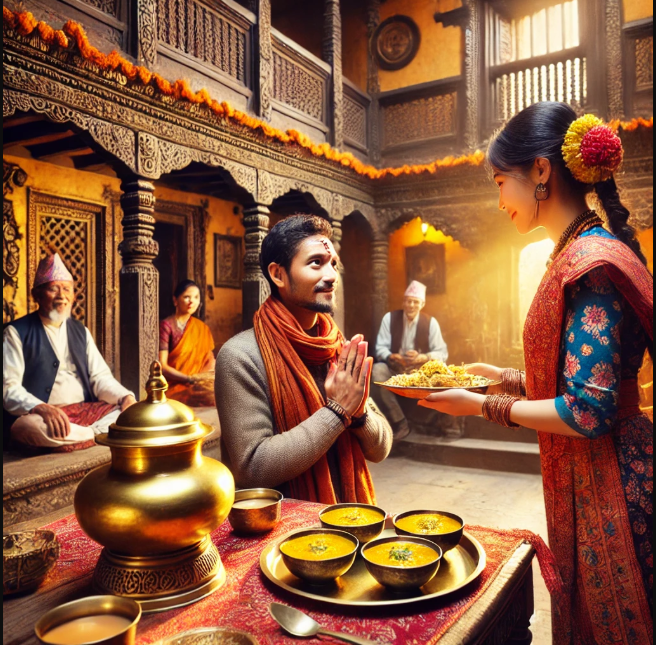
The Heartfelt Hospitality of Nepal
Nepal is a country that captivates with its stunning landscapes and rich cultural heritage, but what truly sets it apart is the incredible hospitality of its people. The warmth and generosity of the Nepali people are woven into their identity, making every visitor feel special. Whether you’re in a bustling city or a remote village, you’ll experience the genuine care and respect that Nepalis extend to their guests, perfectly summed up in the saying:
“अतिथि देवो भवः” (Atithi Devo Bhava) – “Guests are like gods.”
1. The Spirit of Traditional Hospitality
Nepali hospitality is deeply influenced by Hinduism, Buddhism, and local customs, all of which emphasize kindness, respect, and selflessness. Guests—whether they are family, friends, or strangers—are seen as blessings, and hosting them is considered a moral duty.
a. A Warm Welcome
When you arrive at a Nepali home, you’ll likely be greeted with a heartfelt “Namaste” or “Namaskar,” which means “I bow to the divine within you.” In more formal settings or during festivals, you might receive a ceremonial welcome that includes a “Tika” (a mixture of yogurt, rice, and vermillion) and a “Khada” (a silk scarf, especially in Buddhist culture). Flowers and garlands are often presented as symbols of respect and good wishes.
b. Sharing Food and Drink
Food is at the heart of Nepali hospitality. Upon entering a home, you’ll probably be offered a cup of tea (Chiyaa) or a refreshing drink. Traditional Nepali tea is a delightful mix of milk, sugar, and spices like cardamom and ginger. Most homes will serve you Dal Bhat (lentils and rice) along with vegetables, pickles, and sometimes yogurt. It’s considered impolite to leave without sharing a meal, as eating together symbolizes friendship and goodwill.
c. Thoughtful Seating and Manners
In traditional homes, guests are given the best seats, often on comfortable cushions (called “gaddi”) or wooden platforms. Elders are served first as a sign of respect, and you’ll be encouraged to eat your fill. In some households, meals are served on banana leaves or brass plates, adding to the cultural experience.
2. Diverse Hospitality Across Communities
Nepal is a vibrant tapestry of ethnicities and cultures, and hospitality customs can vary widely from one region to another.
a. Hindu Hospitality
In Hindu families, guests are often offered “Prasad” (blessed food) as a gesture of good fortune. Festivals like Dashain and Tihar are celebrated with grand feasts, inviting family and neighbors to join in the festivities.
b. Buddhist Hospitality
In Buddhist communities, such as the Sherpas and Newars, guests are welcomed with “Khada” and butter tea. Monasteries often provide shelter and food to travelers, embodying the Buddhist principles of compassion and generosity.
c. Tharu and Indigenous Hospitality
The Tharu community in the Terai region is known for its lively cultural celebrations. Guests are treated to traditional dances, music, and home-brewed rice beer called “Jand” or “Rakshi.” Indigenous groups like the Gurungs and Magars host communal gatherings where guests are honored with dances like “Ghantu” and “Sorathi.”
3. Hospitality in the Tourism Sector
As a popular destination for trekking, mountaineering, and cultural exploration, Nepal’s hospitality industry plays a vital role in its economy.
a. Tea Houses and Home-Stays
In trekking areas like the Everest and Annapurna circuits, small tea houses offer food and shelter to travelers. Home-stay programs in villages like Ghalegaun and Sirubari allow tourists to immerse themselves in authentic Nepali life, complete with traditional food, folk music, and farming activities.
b. Hotels and Resorts
Nepal’s hospitality sector features a wide range of accommodations, from budget lodges to luxury resorts. Many hotels embrace traditional Nepali architecture and customs, providing guests with an authentic experience.
c. Festival and Religious Hospitality
During major festivals like Holi and Indra Jatra, both locals and tourists are invited to join in the celebrations, fostering a sense of community. Temples and monasteries often offer free meals to pilgrims and travelers, reflecting the concept of “Dana” (charity).
4. Modern Influences on Nepali Hospitality
With the advent of globalization and modernization, Nepali hospitality has evolved while still holding onto its core values.
Restaurants and cafés in urban areas now serve international cuisines, yet they maintain traditional hospitality practices. The rise of eco-tourism and sustainable hospitality encourages responsible travel while preserving Nepal’s unique traditions. Additionally, the digital age has transformed hospitality, with online bookings, reviews, and personalized services becoming increasingly common.
Conclusion
Nepali hospitality is a beautiful blend of tradition, culture, and warmth. Whether you’re staying in a luxurious hotel in Kathmandu or a humble home in the Himalayas, you’ll always be met with kindness and generosity. The essence of Nepali hospitality lies in its simplicity and heartfelt welcome, making visitors feel like part of the family. This strong cultural value continues to position Nepal as one of the most welcoming destinations in the world.